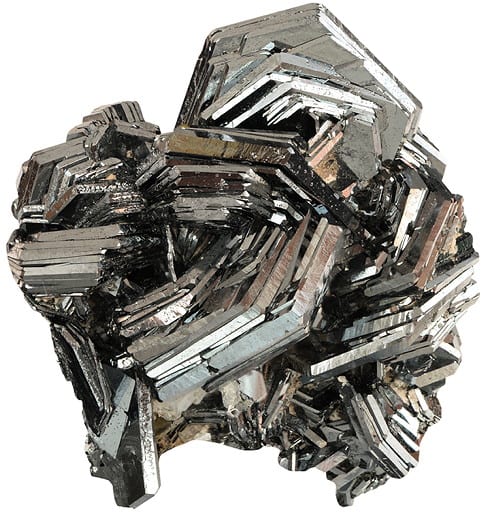Hematite Iron Oxide
Introduction
Hematite is a naturally occurring iron oxide with the chemical formula Fe2O3. It is mined from many deposits worldwide and although the vast majority is used to make iron and steel. It is also dissolves in acid for make water-purification. The many special properties of hematite make it suitable for other applications, including as a filler for plastics and coatings. It shares several attractive features with magnetite, another iron oxide. The most common type of hematite is a dull looking grey/red ore. However, other forms exist. One is micaceous iron oxide shown to the right. Due to the lamellar particle shape it provides a barrier effect useful in anti-corrosion coatings. Top quality micaceous iron oxide known as MIOX® is sold by KMI in Europe and their distributor the Kish Company in the USA. Another type known as specular hematite is also shiny but composed of more granular, non platy particles. Some more about hematite can be found on this page.

Chemical formula: Fe2O3
CAS Number: 1317-60-8 or 76774-74-8
RMM: 159.69
Density: 5.3 gcm-3
Mohs hardness: 5.5 – 6.5
Colour: Grey, shiny (red for very fine particles)
Refractive index: 3.2, 2.9 (birefringence 0.028)
Melting point: >1565°C / >2850°F
CTE: 9 x 10-6 K-1
Thermal conductivity: 12.5 Wm-1K1
Specific heat capacity: 0.61 kJkg-1K-1 3.25 kJL-1K-1
Dielectric constant: 2 – 22 (reported values vary widely)
Solubility: Insoluble in water, bases & solvents, dissolves in acid
Reactivity: Unreactive (except to acids)
Hematite Applications
Dense plastics
Can be used to add mass in various plastic parts made from e.g. polypropylene, polyamides (nylons) and polyethylene. High weight can be useful to impart a high quality feeling to a material or for sound damping. Loadings of 80 weight% easily achievable giving composite densities of around 3.0 gcm-3. As we shall see, there are many areas where hematite can add value.
For aesthetics
Can be used as pigment where it can impart an attractive grey metallic sparkle. Coarser grades with angular facets are very effective. Specularite, a platy form of hematite, gives especially attractive effects. Finer ground or precipitated hematite is red and sometimes referred to as rouge. It is used both as a pigment and as an abrasive.
As a tracer
Plastics can be difficult to detect. Hematite has both magnetic and electrical properties, plus, its has very high density making it x-ray opaque. Thus, this specialty filler, makes plastics detectable. Detectable plastics are especially sought after in medical applications, for plastics used in food processing and for anti-counterfeiting.
Radiation blocking
It has been shown that this iron oxide filler is just as effective as magnetite for radiation blocking concrete. The high density of the hematite enables excellent blocking performance and the high strength of the hematite provides good mechanical properties for the concrete.
For microwave or induction heatability
Plastics are microwave transparent and do not heat by induction because they are electrical insulators without any magnetic properties. Hematite is added to polymers to allow them to be heated either by microwaves or using induction. The pure iron oxide powder heats up very quickly in a microwave oven, approximately 200°C per minute in a standard domestic oven.
Heat transfer
There are applications requiring heat transfer and hematite has high heat conductivity making it an attractive, low cost, specialty filler to meet such requirements. Hematite has a thermal conductivity of 12.5 Wm-1K-1, which is exceptionally high, more than double the conductivity of magnetite and 3-4 times higher than for common fillers like barium sulfate and calcium carbonate (calcite).
Magnetism
Hematite is attracted to a magnet, although much less strongly compared to magnetite black iron oxide. Nevertheless, the magnetic property can be useful in some situations. For example, when added to a plastic, it makes that plastic detectable and sortable for recycling.
Conclusion
Hematite is a multi-functional filler for plastics. Although not yet widely known, it has high potential. This article and the information below serve, hopefully, to increase awareness of the specialty filler and what it can do. Phantom Plastics has assembled a large amount of information to help customers develop new applications. High purity hematite filler is now commercially available. Contact us for more information and to arrange samples.
